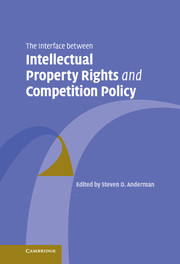Book contents
- Frontmatter
- Contents
- Notes on contributors
- Preface
- 1 The competition law/IP ‘interface’: an introductory note
- PART I Intellectual property rights and competition law in the major trading blocks
- 2 EC competition policy and IPRs
- 3 Competition policy and its implications for intellectual property rights in the United States
- 4 The interface between competition law and intellectual property in Japan
- PART II Intellectual property rights and competition law in smaller and medium sized open economies
- PART III Issues related to the interface between intellectual property rights and competition law
- Index
3 - Competition policy and its implications for intellectual property rights in the United States
Published online by Cambridge University Press: 27 July 2009
- Frontmatter
- Contents
- Notes on contributors
- Preface
- 1 The competition law/IP ‘interface’: an introductory note
- PART I Intellectual property rights and competition law in the major trading blocks
- 2 EC competition policy and IPRs
- 3 Competition policy and its implications for intellectual property rights in the United States
- 4 The interface between competition law and intellectual property in Japan
- PART II Intellectual property rights and competition law in smaller and medium sized open economies
- PART III Issues related to the interface between intellectual property rights and competition law
- Index
Summary
Introduction: innovation and competition
At the federal level of US law, both intellectual property protection and antitrust policy share a common goal of encouraging innovation. But observers agree that this common goal is achieved by different approaches – antitrust policy by fostering competition and patent and copyright policies by granting rights to exclude rivals. Still, this distinction of means is not absolute: antitrust permits some exclusionary strategies and intellectual property policy fosters some competition. In consequence, both approaches must be understood as balancing property protection and competition, exclusion and access and, ultimately, private rights and public benefits.
The several states provide a second level of intellectual property protection: each state protects intellectual property through its own trade secret and trademark laws. In contrast to the European Union, whose federalism is informed by a policy imperative to harmonise the laws of individual states with those of the Union, federalism in the United States is not guided by one clear imperative. On the one hand, the US Constitution's supremacy clause means just that: where federal and state laws conflict, federal law is supreme. On the other hand, federal law often leaves room for state law, regardless of policy conflict, and sometimes invites states to regulate. In the domain of trademark protection, federal law does even more – the Lanham Act was passed to supplement state laws. But in other areas of overlap, such as federal patents and state trade secrets, policy differences sometimes call for limitations on state law rights.
- Type
- Chapter
- Information
- Publisher: Cambridge University PressPrint publication year: 2007
- 2
- Cited by



